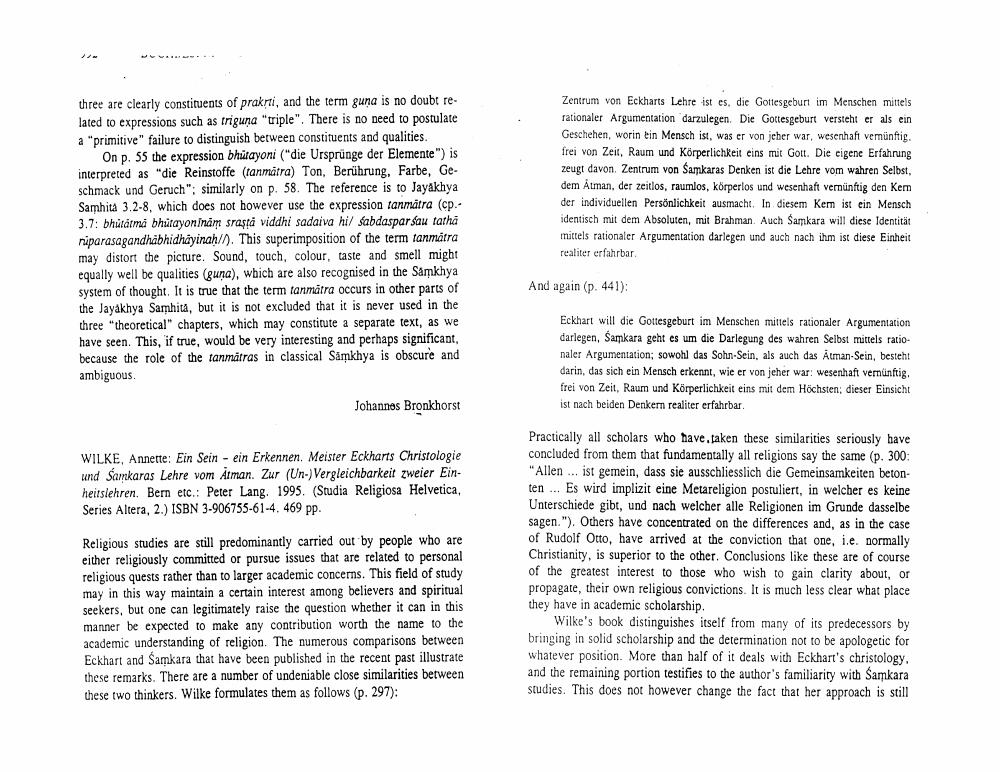________________
three are clearly constituents of prakrti, and the term guna is no doubt related to expressions such as triguna "triple". There is no need to postulate a "primitive" failure to distinguish between constituents and qualities.
On p. 55 the expression bhitayoni ("die Ursprünge der Elemente") is interpreted as "die Reinstoffe (tanmatra) Ton, Berührung. Farbe, Geschmack und Geruch": similarly on p. 58. The reference is to Jayakhya Samhita 3.2-8, which does not however use the expression tanmatra (cp.3.7: bhutátmá bhitayoninām srasta viddhi sadaiva hi/ Sabdaspar sau tatha niparasagandhabhidhayinah//). This superimposition of the term tanmatra may distort the picture. Sound, touch, colour, taste and smell might equally well be qualities (guna), which are also recognised in the Samkhya system of thought. It is true that the term tanmatra occurs in other parts of the Jayakhya Samhita, but it is not excluded that it is never used in the three "theoretical chapters, which may constitute a separate text, as we have seen. This, if true, would be very interesting and perhaps significant, because the role of the tanmatras in classical Samkhya is obscure and ambiguous.
Zentrum von Eckharts Lehre ist es, die Gottesgeburt im Menschen mittels rationaler Argumentation darzulegen. Die Gottesgeburt versteht er als ein Geschehen, worin ein Mensch ist, was er von jeher war, wesenhaft vemünftig. frei von Zeit, Raum und körperlichkeit eins mit Gott. Die eigene Erfahrung zeugt davon Zentrum von Samkaras Denken ist die Lehre vom wahren Selbst, dem Alman, der zeitlos, raumlos, körperlos und wesenhaft vernünftig den Kem der individuellen Persönlichkeit ausmacht. In diesem Kem ist ein Mensch identisch mit dem Absoluten, mit Brahman. Auch Samkara will diese Identität mittels rationaler Argumentation darlegen und auch nach ihm ist diese Einheit realiter erfahrbar.
And again (p. 441):
Eckhart will die Gottesgeburt im Menschen mittels rationaler Argumentation darlegen, Samkara geht es um die Darlegung des wahren Selbst mittels rationaler Argumentation; sowohl das Sohn Sein, als auch das Alman-Sein, besteht darin, das sich ein Mensch erkennt, wie er von jeher war: wesenhaft vernünftig, frei von Zeit, Raum und Körperlichkeit eins mit dem Höchsten; dieser Einsicht ist nach beiden Denkern realiter erfahrbar.
Johannes Bronkhorst
WILKE, Annette: Ein Sein - ein Erkennen. Meister Eckharts Christologie und Samkaras Lehre vom Atman. Zur (Un) Vergleichbarkeit zweier Einheitslehren. Bern etc.: Peter Lang. 1995. (Studia Religiosa Helvetica, Series Altera, 2.) ISBN 3-906755-61-4.469 pp.
Religious studies are still predominantly carried out by people who are either religiously committed or pursue issues that are related to personal religious quests rather than to larger academic concerns. This field of study may in this way maintain a certain interest among believers and spiritual seekers, but one can legitimately raise the question whether it can in this manner be expected to make any contribution worth the name to the academic understanding of religion. The numerous comparisons between Eckhart and Samkara that have been published in the recent past illustrate these remarks. There are a number of undeniable close similarities between these two thinkers. Wilke formulates them as follows (p. 297):
Practically all scholars who have taken these similarities seriously have concluded from them that fundamentally all religions say the same (p. 300: "Allen ... ist gemein, dass sie ausschliesslich die Gemeinsamkeiten beton ten ... Es wird implizit eine Metareligion postuliert, in welcher es keine Unterschiede gibt, und nach welcher alle Religionen im Grunde dasselbe sagen."). Others have concentrated on the differences and, as in the case of Rudolf Otto, have arrived at the conviction that one, i.e. normally Christianity, is superior to the other. Conclusions like these are of course of the greatest interest to those who wish to gain clarity about, or propagate, their own religious convictions. It is much less clear what place they have in academic scholarship
Wilke's book distinguishes itself from many of its predecessors by bringing in solid scholarship and the determination not to be apologetic for whatever position. More than half of it deals with Eckhart's christology. and the remaining portion testifies to the author's familiarity with Samkara studies. This does not however change the fact that her approach is still




